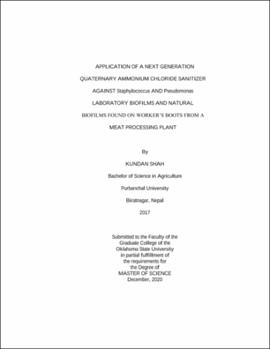| dc.contributor.advisor | Muriana, Peter M. | |
| dc.contributor.author | Shah, Kundan | |
| dc.date.accessioned | 2021-05-25T21:00:23Z | |
| dc.date.available | 2021-05-25T21:00:23Z | |
| dc.date.issued | 2020-12 | |
| dc.identifier.uri | https://hdl.handle.net/11244/330001 | |
| dc.description.abstract | Foodborne pathogens are known to adhere strongly to surfaces and can form biofilms in food processing facilities whereby the potential to contaminate manufactured foods underscores the importance of sanitation, but all too often they are applied with little or no validation. | |
| dc.description.abstract | The objective of the study was to 1) confirm sanitizer (Decon7) effectiveness on biofilms of Staphylococcus and Pseudomonas, 2) validate sanitizer effectiveness on workers' boots from a slaughter floor environment, 3) identify biofilm bacteria from old boots in relation to previous sanitizer chemistry, and 4) evaluate enzymatic treatment to breakdown biofilms prior to sanitizer application. | |
| dc.description.abstract | A sanitizer that demonstrated superior effectiveness against E. coli O157:H7, Salmonella spp., and L. monocytogenes was applied at two concentrations against enhanced biofilms of strains of Staphylococcus spp. and Pseudomonas spp. (as required by EPA) in 96-wells microplates. Additionally, worker boots were swabbed with a trypsin solution and then treated with the sanitizer spray solution. Bacteria isolated (before treatment) were identified by 16S rRNA PCR and DNA sequencing. | |
| dc.description.abstract | All treatments were carried out in triplicate replication and analyzed by RM-ANOVA using the Holm-Sidak test for pairwise multiple comparisons to determine significant differences (p < 0.05). The data show a significant difference between sanitizer treatment and control groups. There was a ~4-5 log reduction of bacterial strains (microplate assay) within the first 1 min of treatment and also greater > 3-log reduction in bacterial population from encrusted biofilms from workers' boots. | |
| dc.description.abstract | The new, next-generation QAC (quad) sanitizers may be more effective than prior single/dual-QAC sanitizers and enzyme pre-treatment can facilitate biofilm sanitizer penetration on any food contact surface. Rotation of sanitizer chemistries may prevent selective retention of chemistry-tolerant microorganisms if they may occur. | |
| dc.format | application/pdf | |
| dc.language | en_US | |
| dc.rights | Copyright is held by the author who has granted the Oklahoma State University Library the non-exclusive right to share this material in its institutional repository. Contact Digital Library Services at lib-dls@okstate.edu or 405-744-9161 for the permission policy on the use, reproduction or distribution of this material. | |
| dc.title | Application of a next generation quaternary ammonium chloride sanitizer against Staphylococcus and Pseudomonas laboratory biofilms and natural biofilms found on workers' boots from a meat processing plant | |
| dc.contributor.committeeMember | Jadeja, Ravi | |
| dc.contributor.committeeMember | Ramanathan, Ranjith | |
| osu.filename | Shah_okstate_0664M_17013.pdf | |
| osu.accesstype | Open Access | |
| dc.type.genre | Thesis | |
| dc.type.material | Text | |
| dc.subject.keywords | biofilm | |
| dc.subject.keywords | sanitizer | |
| dc.subject.keywords | l. monocytogenes | |
| dc.subject.keywords | salmonella | |
| dc.subject.keywords | e. coli o157:h7 | |
| dc.subject.keywords | pseudomonas | |
| dc.subject.keywords | staphylococcus | |
| dc.subject.keywords | microplate assay | |
| thesis.degree.discipline | Food Science | |
| thesis.degree.grantor | Oklahoma State University | |
